Thursday, December 22, 2005
Regulator
I picked up an Analog Devices ADP3338 regulator to power the MP3 player. I am using one with Vin up to 8V, and Vout is 1.8V.
Speed and Detection
I'm enamored with the use of the ultrasonic range sensor for Blame. It currently gives me a very solid indication of anything within 5 feet. The active IR sensors can theoretically detect up to 5 feet, but they really get noisy out beyond 4 feet.
For Look, Scott and I chose passive IR motion sensors because we wanted a larger range, plus Look moves its eyes at motion now, rather than just detection of someone.
For Sycophant, ultrasonic range sensors would have been bad because of 1) clicking noise 2) inter-sensor interference and 3) latency (the ultrasonic sensors need about 0.3 second to get a good reading). Sycophant needs to move down the track really fast when it detects someone, and it is continuously talking.
For Blame, ultrasound works because 1) the clicking is kind of cool and creepy 2) I can turn the sensor off when the work is talking and 3) people might not get too close to the swinging arm, so a long distance is needed and 4) if people crowd around it, the long distance of sensing is less of a problem because it can accuse anyone in the crowd, then move to someone else.
On PWM, currently I am using the 1:4 prescalar on TMR0, with a 4khz internal clock. The on period of the PWM begins at 0xC0. This moves the arm a little fast, but moving the on period to begin at 0xD0 makes the arm a bit weak. I might have to re-jigger the prescalar to 1:2 then drop the on period length to get a solid yet slower movement.
For Look, Scott and I chose passive IR motion sensors because we wanted a larger range, plus Look moves its eyes at motion now, rather than just detection of someone.
For Sycophant, ultrasonic range sensors would have been bad because of 1) clicking noise 2) inter-sensor interference and 3) latency (the ultrasonic sensors need about 0.3 second to get a good reading). Sycophant needs to move down the track really fast when it detects someone, and it is continuously talking.
For Blame, ultrasound works because 1) the clicking is kind of cool and creepy 2) I can turn the sensor off when the work is talking and 3) people might not get too close to the swinging arm, so a long distance is needed and 4) if people crowd around it, the long distance of sensing is less of a problem because it can accuse anyone in the crowd, then move to someone else.
On PWM, currently I am using the 1:4 prescalar on TMR0, with a 4khz internal clock. The on period of the PWM begins at 0xC0. This moves the arm a little fast, but moving the on period to begin at 0xD0 makes the arm a bit weak. I might have to re-jigger the prescalar to 1:2 then drop the on period length to get a solid yet slower movement.
Saturday, December 03, 2005
Ultrasonic Proximity Detectors
A while back I picked up some ultrasonic proximity detectors from BG Micro (they don't seem to have them any more). They appear to be called "Mini-S Sensors", and have one output that detects at 7 feet, and one that detects at 5 feet.
More info on them is here.
Blame progress is coming around nicely. I have a nice steel superstructure now. I picked up some 4066 Quad Switches to control the button switches MP3 player (the strategy appears to work, hurrah!). And am painting the arm of Blame to get a nice image for the gallery postcard.
More info on them is here.
Blame progress is coming around nicely. I have a nice steel superstructure now. I picked up some 4066 Quad Switches to control the button switches MP3 player (the strategy appears to work, hurrah!). And am painting the arm of Blame to get a nice image for the gallery postcard.
Tuesday, November 29, 2005
Arcade Electronics
So where do you go when you need a DB25 IDC connector right away? Arcade Electronics, which is just north of Springfield. Lots of good electronics, reasonable prices, no shipping if you just show up and buy it.
I stopped by Scott Hutchison's studio last night. We are evaluating whether we like the behavior of Look better with active IR sensors or passive IR (PIR)sensors. The jury is still out.
PIR sensors for home security systems generally operate like a relay. If there is "no intruder," they are either "normally open" circuit or "normally closed" circuit.
I'm always scared of blowing out PC parallel ports, so instead of using potentially hazardous voltage pull-ups and pull-downs to detect whether relays are open or closed, I hook the relay between a parallel port output and an input. I then drive the output up and down a few times. If the input pin follows the output pin every time, you know the relay is closed. Otherwise, it is open.
I stopped by Scott Hutchison's studio last night. We are evaluating whether we like the behavior of Look better with active IR sensors or passive IR (PIR)sensors. The jury is still out.
PIR sensors for home security systems generally operate like a relay. If there is "no intruder," they are either "normally open" circuit or "normally closed" circuit.
I'm always scared of blowing out PC parallel ports, so instead of using potentially hazardous voltage pull-ups and pull-downs to detect whether relays are open or closed, I hook the relay between a parallel port output and an input. I then drive the output up and down a few times. If the input pin follows the output pin every time, you know the relay is closed. Otherwise, it is open.
Wednesday, November 23, 2005
January show at Fraser Bethesda
I will take part in the "Art and Technology" group show at Fraser Gallery, Bethesda. Here are the details:
JANUARY 2006 - ART AND TECHNOLOGY
January 13 - February 8, 2006
Opening Reception - Friday, January 13 from 6pm - 9pm.
Other folks in the show include Scott Hutchison (who just got written up in a DC Magazine article), Claire Watkins (who does some really cool organic/technologic kinetic sculptures), David Page (who makes interesting "apparatus" that is sometimes fetish related).
JANUARY 2006 - ART AND TECHNOLOGY
January 13 - February 8, 2006
Opening Reception - Friday, January 13 from 6pm - 9pm.
Other folks in the show include Scott Hutchison (who just got written up in a DC Magazine article), Claire Watkins (who does some really cool organic/technologic kinetic sculptures), David Page (who makes interesting "apparatus" that is sometimes fetish related).
Tuesday, November 22, 2005
"Blame" Swings
Sorry for the low quality, but here is the Canon SD400 with a Quicktime movie of the test rig for Blame.
I am using Radio Shack magnetic reed switches which can operate with a gap of up to 1 inch between the magnet and the switch. I think the arm is swinging too fast, I'll have to turn down the PWM duty cycle.
I am using Radio Shack magnetic reed switches which can operate with a gap of up to 1 inch between the magnet and the switch. I think the arm is swinging too fast, I'll have to turn down the PWM duty cycle.
"Blame" hand
As an early birthday present, I got a Canon SD400. A very nice little camera!
Here is a picture of the hand of Blame:
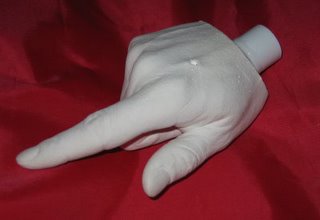
It came out pretty good, except for that little "zit" on the top, which I have since filled in with a little bit of stone. I attached the hand to a CPVC slip end cover using a masonry screw and a big gob of Loctite Epoxy Gel (which is supposed to work with plastics and ceramics). Later, I epoxied the CPVC slip end cover to the "arm" CPVC pipe.
I have found a great site for "random" stuff like motors, power supplies, and PIR detectors: MPJA.com.
Finally, the work I am doing with Scott Hutchison, now named Look, got mentioned at DCist.
Here is a picture of the hand of Blame:

It came out pretty good, except for that little "zit" on the top, which I have since filled in with a little bit of stone. I attached the hand to a CPVC slip end cover using a masonry screw and a big gob of Loctite Epoxy Gel (which is supposed to work with plastics and ceramics). Later, I epoxied the CPVC slip end cover to the "arm" CPVC pipe.
I have found a great site for "random" stuff like motors, power supplies, and PIR detectors: MPJA.com.
Finally, the work I am doing with Scott Hutchison, now named Look, got mentioned at DCist.
Good Stuff in NYC
Not terribly tech-oriented, but last time I was in Chelsea, I saw these great glass sculptures by Mari Meszaros. I hate a lot of glass art, but like Tim Tate, Meszaros really has found a unique way of expressing through glass.
Monday, November 14, 2005
"Look"-ing Good
Yesterday I stopped by Scott Hutchison's studio to do some work on Look, a work we are collaborating on with his great eye paintings and my computer and sensor technology.
Scott took some video of his wife helping us test the work available here.
We're still deciding if we are going to use active IR sensors or passive IR motion sensors. The behvior of the system is a bit different with active or passive. With active, you can sense someone who is in front of the sensor, but not moving. With passive, you can detect people very far away in a wide swath of area, but only if they are moving. I had no choice with Sycophant, as the head was moving itself, so motion detection was not practical, and I used active IR sensors in that project. In Look, the sensors will not be moving, so the choice is a bit harder.
Here is the test setup for Look:

Scott took some video of his wife helping us test the work available here.
We're still deciding if we are going to use active IR sensors or passive IR motion sensors. The behvior of the system is a bit different with active or passive. With active, you can sense someone who is in front of the sensor, but not moving. With passive, you can detect people very far away in a wide swath of area, but only if they are moving. I had no choice with Sycophant, as the head was moving itself, so motion detection was not practical, and I used active IR sensors in that project. In Look, the sensors will not be moving, so the choice is a bit harder.
Here is the test setup for Look:

Wednesday, November 09, 2005
Casting and Notes
Last night, I made a casting of my pointing hand for Blame using a kit from Casting Keepsakes. It wasn't too tough to do, but you definately want to read the instructions fully, and use disposable bowls for mixing, because you certainly won't want to use them for anything afterwards. Unfortunately, I go to New York tonight, so I can't see how it came out until Saturday night.
Check out the Windows Washing Machine!
On my last trip to New York City, I saw work by Mark Napier at Bitforms (my favorite gallery). It allowed the viewer to manipulate a deformable wireframe model of the Empire State Building. It was a pretty fun interactive work!
Check out the Windows Washing Machine!
On my last trip to New York City, I saw work by Mark Napier at Bitforms (my favorite gallery). It allowed the viewer to manipulate a deformable wireframe model of the Empire State Building. It was a pretty fun interactive work!
Sunday, October 30, 2005
PWM success & failure
So I have PWM working on the PIC 16F684A. I intended to use it with the DC motor controller based on the L298.
Well, PWM into the I1 and I2 inputs (the direction inputs) works fine, but PWM into the Enable input causes the circuit to screw up in some way, it looks like perhaps trying to drive the motor in two directions at once. My theory was to move the I1 and I2 lines to indicate direction, and use the enable to provide the PWM slow-down of the windshield wiper motor. I think I blew out a 16F684A in the process of testing.
Now I need to change things around to PWM into the I1 and I2 inputs, and just leave Enable tied to high. Since the 16F684 only has one PWM output, I am either going to have to use it with an AND gate to gate the I1 and I2 signals, or I could go back to the drawing board and make my own I1 and I2 PWM outputs using times interrupts on the 16F684A. I'm a big believer in reducing chip count, and I'd like to learn about timed interrupts on the PICs, so I will try to do it the latter way, and if I fail, I can just throw an AND chip at the problem.
Well, PWM into the I1 and I2 inputs (the direction inputs) works fine, but PWM into the Enable input causes the circuit to screw up in some way, it looks like perhaps trying to drive the motor in two directions at once. My theory was to move the I1 and I2 lines to indicate direction, and use the enable to provide the PWM slow-down of the windshield wiper motor. I think I blew out a 16F684A in the process of testing.
Now I need to change things around to PWM into the I1 and I2 inputs, and just leave Enable tied to high. Since the 16F684 only has one PWM output, I am either going to have to use it with an AND gate to gate the I1 and I2 signals, or I could go back to the drawing board and make my own I1 and I2 PWM outputs using times interrupts on the 16F684A. I'm a big believer in reducing chip count, and I'd like to learn about timed interrupts on the PICs, so I will try to do it the latter way, and if I fail, I can just throw an AND chip at the problem.
Friday, October 28, 2005
PWM example on 16F648A
Yep, I've got PWM working fine on my 16F648A...
title "Blame PWM test"
list p=16f648a,f=inhx32
#include
__config _INTOSC_OSC_NOCLKOUT & _WDT_OFF & _PWRTE_OFF & _BODEN_OFF & _MCLRE_OFF & _LVP_OFF
org 00h
goto Start
org 0x005
Start
BANKSEL PCON
BSF PCON,3 ; clear bit 3 of pcon (OSCF) for 4 kHz operation.
MOVLW 0xFF ;PWM value
BANKSEL PR2
MOVWF PR2
BANKSEL CCPR1L
MOVLW 0x1F ; 50% duty cycle = 0x7F
MOVWF CCPR1L
;note, I'm ignoring the duty cycle LSBs at CCP1CON<5:4>
BANKSEL TRISB
BCF TRISB,3 ;make CCP1 an output
BANKSEL T2CON
BSF T2CON,2 ;enable timer 2
BSF T2CON,1 ;1:16 prescaler
BANKSEL CCP1CON
BSF CCP1CON,3
BSF CCP1CON,2 ;configure CCP1 for PWM
loop GOTO loop
end
Tuesday, October 25, 2005
New PIC chips
There seem to be all kinds of new cool PIC chips, good info here. In particular, the 16F819 has 5 channels of A/D, I might use this for the next generation Sycophant.
The current Sycophant IR proximity detectors are used in a binary fashion, either someone is within range or not. But the detectors are actually analog, so they could be used in a more intelligent way.
In particular, I noticed that when installed in a crowded room, Sycophant locks up because the crowd will end up being "in range" for more than one detector. With A/D, I could have Sycophant's head always move towards the IR detector which indicates someone is closer. In addition, the minimal distance for activating movement could be set in software instead of with a trimmer potentiometer.
The current Sycophant IR proximity detectors are used in a binary fashion, either someone is within range or not. But the detectors are actually analog, so they could be used in a more intelligent way.
In particular, I noticed that when installed in a crowded room, Sycophant locks up because the crowd will end up being "in range" for more than one detector. With A/D, I could have Sycophant's head always move towards the IR detector which indicates someone is closer. In addition, the minimal distance for activating movement could be set in software instead of with a trimmer potentiometer.
Wednesday, October 12, 2005
Note to Self: PIC compilers
The HI-TECH PICC-Lite compiler is a freeware version of our the PICC compiler and supports the 16F877, 16F877A, 12F675, 12F629, 16F627, 16F627A, 16F684, 16C84, 16F84 and 16F84A devices.
The 16F684 has 8 A/D and 2 comparators and is in a 14PDIP. It isn't a target for the MPLAB IDE version I have, I'll have to get a newer version and check it. The 16F877A is supported by MPLAB, has A/D and comparators, but is a big 40PDIP. The 12F675 has 4 A/D and 1 comparator, but is a little bitty 8PDIP.
On the other hand, this PIC BASIC compiler works with: 12F629, 12F675, 16F627, 16F627A, 16F628, 16F628A, 16F630, 16F648A, 16F676, 16F684, 16F688, 16F72, 16F73, 16F74, 16F76, 16F77, 16F737, 16F747, 16F767, 16F777, 16F83, 16F84, 16F84A, 16F87, 16F88, 16F818, 16F819, 16F870, 16F871, 16F872, 16F873, 16F873A, 16F874, 16F874A, 16F876, 16F876A, 16F877, 16F877A.
The 16F684 has 8 A/D and 2 comparators and is in a 14PDIP. It isn't a target for the MPLAB IDE version I have, I'll have to get a newer version and check it. The 16F877A is supported by MPLAB, has A/D and comparators, but is a big 40PDIP. The 12F675 has 4 A/D and 1 comparator, but is a little bitty 8PDIP.
On the other hand, this PIC BASIC compiler works with: 12F629, 12F675, 16F627, 16F627A, 16F628, 16F628A, 16F630, 16F648A, 16F676, 16F684, 16F688, 16F72, 16F73, 16F74, 16F76, 16F77, 16F737, 16F747, 16F767, 16F777, 16F83, 16F84, 16F84A, 16F87, 16F88, 16F818, 16F819, 16F870, 16F871, 16F872, 16F873, 16F873A, 16F874, 16F874A, 16F876, 16F876A, 16F877, 16F877A.
Monday, October 10, 2005
Art-O-Matic and Motor Controller
Friday I met with Claudia Vess and Brian Judy who ran last year's Art-O-Matic Digital Art committee. The next Art-O-Matic will occur in late October, 2006. Also attending was Philip Kohn, who exhibited at Art-O-Matic and has been doing very cool things along the lines of a mirror, except with highly modulated and distorted video.
One of the things we decided we wanted to do for Art-O-Matic 2006 is to have an "Art-O-Mobile" using mobile IP to provide a videoconference link betwen Art-O-Matic's main location and remote locations, using video projectors.
Today I built a DC motor controller kit from Hobby Engineering. It handles up to 4A, and seems to work well with the windshield wiper motor for "Blame". The wiper motor draws about 0.75 A with no load, and about 0.8A with the PVC pipe load which forms the arm of "Blame".
Here is the finished motor controller:
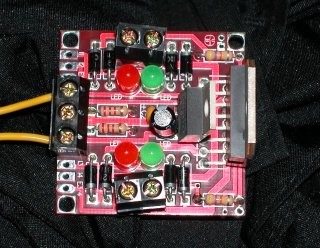
One of the things we decided we wanted to do for Art-O-Matic 2006 is to have an "Art-O-Mobile" using mobile IP to provide a videoconference link betwen Art-O-Matic's main location and remote locations, using video projectors.
Today I built a DC motor controller kit from Hobby Engineering. It handles up to 4A, and seems to work well with the windshield wiper motor for "Blame". The wiper motor draws about 0.75 A with no load, and about 0.8A with the PVC pipe load which forms the arm of "Blame".
Here is the finished motor controller:

Thursday, September 29, 2005
Regulators and Controllers
Note to self: forget the 7805, instead go for the pin-compatible LM2937 which only needs 5.5V input to provide a regulated 5.0V output up to 500mA. This actually would be nice if I ever rebuild Sycophant, because a lot of RC cars run on 6V, which isn't quite enough for a good 5V from a 7805.
Meanwhile I think I've found a nice H-Bridge circuit, I have to double check that the Saturn windshield wiper motor doesn't pull more than 4A from my 12V supply. I'll have a PIC microcontroller do PWM through it and have the motor go back and forth to move the arm for Blame.
Meanwhile I think I've found a nice H-Bridge circuit, I have to double check that the Saturn windshield wiper motor doesn't pull more than 4A from my 12V supply. I'll have a PIC microcontroller do PWM through it and have the motor go back and forth to move the arm for Blame.
Monday, September 26, 2005
Cheaper Sonar
Acroname now has a $25 sonar sensor which senses up to 4 meters. Documentation is available here.
I tested the Saturn windshield wiper last night with my big-Amp 12V supply. Looks good, tons of torque, but even the slowest setting may still be too fast. A DC motor controller circuit may be in my future.
I tested the Saturn windshield wiper last night with my big-Amp 12V supply. Looks good, tons of torque, but even the slowest setting may still be too fast. A DC motor controller circuit may be in my future.
Sunday, September 25, 2005
Saturn Motor
I just purchased a Saturn windshield wiper from BG Micro to drive the pointing hand for Blame.
I had a good chat with Scott today about the eyes project...things are looking good!
I had a good chat with Scott today about the eyes project...things are looking good!
Thursday, September 22, 2005
Cheap Small MP3 Player
When I originally installed Sycophant at Art-O-Matic 2004, I used a small Fujitsu Stylistic 1200 pen-based PC to provide the audio using WAV files played back when the PIC microcontroller on the head requested audio through a parallel port signal. The audio was great! But I had problems with the PC crashing, long boot times, etc.
When I went to show Sycophant at the Fraser Gallery, I decided to use a Windbond chipcorder as a solid-state way of doing the audio and getting rid of the PC. The system was now very solid and came on within one second of power-up. But the audio sounded pretty bad.
My next project, Blame, will involve an arm swinging back and forth, stopping when pointing at a person, and blaming them for something horrible (global warming, war, loss of morals, sexual promiscuity, etc.) I wanted better audio, so I looked around for a cheap flash-based MP3 player I could hack for the project to replace the chipcorder.
At Flash Memory Store, which has all kinds of digital storage products, I found the IMP3 SD/MMC card-based MP3 player, which also has a thumb-drive style USB interface. It looks like I can just hook up some N-FETs across the push-switches to drive it. Here are some pictures:
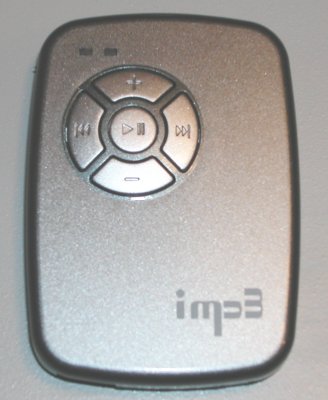
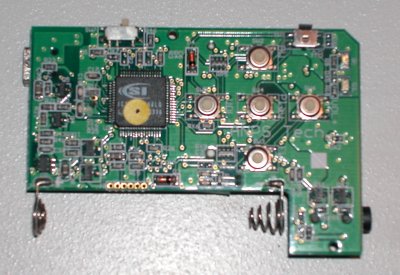
When I went to show Sycophant at the Fraser Gallery, I decided to use a Windbond chipcorder as a solid-state way of doing the audio and getting rid of the PC. The system was now very solid and came on within one second of power-up. But the audio sounded pretty bad.
My next project, Blame, will involve an arm swinging back and forth, stopping when pointing at a person, and blaming them for something horrible (global warming, war, loss of morals, sexual promiscuity, etc.) I wanted better audio, so I looked around for a cheap flash-based MP3 player I could hack for the project to replace the chipcorder.
At Flash Memory Store, which has all kinds of digital storage products, I found the IMP3 SD/MMC card-based MP3 player, which also has a thumb-drive style USB interface. It looks like I can just hook up some N-FETs across the push-switches to drive it. Here are some pictures:


Monday, September 19, 2005
Forget 7805's
Well, I am now done with linear voltage regulators like the 7805. For some reason, it could only hold the circuit at 4.7 V with some significant irregularity, even when fed with 12VDC. The IR sensors were not very stable at the slightly lower voltage, and the output digital levels were not solid.
So I swapped out the 7805 for a Cosel YS505U "Gorilla" AC-to-DC converter I had laying around. Now I have a nice solid 5V of up to 1A, and everything is happy. The IR sensors are now responding properly, and my Visual Basic program can read them through the parallel port input.
Tommorow night I am going to work on the software a bit, hopefully to include some sound along with the animated eyes. Scott may be coming over Wednesday to see the progress. He's been painting new eyes.
On another note, Jesse from ArtDC.Org sent me a link to Noboru Tsubaki's work that includes a large fiberglass insect that lures visitors into its "web". His UN Boy project includes a 16-foot tall Teddy Bear and a mine-clearing robot.
So I swapped out the 7805 for a Cosel YS505U "Gorilla" AC-to-DC converter I had laying around. Now I have a nice solid 5V of up to 1A, and everything is happy. The IR sensors are now responding properly, and my Visual Basic program can read them through the parallel port input.
Tommorow night I am going to work on the software a bit, hopefully to include some sound along with the animated eyes. Scott may be coming over Wednesday to see the progress. He's been painting new eyes.
On another note, Jesse from ArtDC.Org sent me a link to Noboru Tsubaki's work that includes a large fiberglass insect that lures visitors into its "web". His UN Boy project includes a 16-foot tall Teddy Bear and a mine-clearing robot.
Sunday, September 18, 2005
New Eyes Circuit
Welcome to my new Tech Art blog! I decided that I want to keep a separate blog dedicated to my art projects, and other cool tech artwork, for my own reference and the elucidation of others.
To bring you up to speed, I am working on a collaboration with painter/video artist Scott Hutchison. It will be a slot where computer projected images of eyes will follow you as you walk by the work. The eyes will actually be Scott's eyes, as painted and animated by him. My part to play is the sensor work and software behind it.
Here is an image of the wire-wrap board for the Eyes project. Right now there is just a 7805 5V regulator, a potentiometer to set the distance desired for the sensors, the three Sharp GP2Y0A02YK long-range IR distance sensors (long-range being 5 feet...) an LM324 analog comparator chip (which compares the analog distance voltage to the potentiometer voltage) and a 7408 quad 2-input AND chip used as a buffer to help drive the digital parallel port inputs.
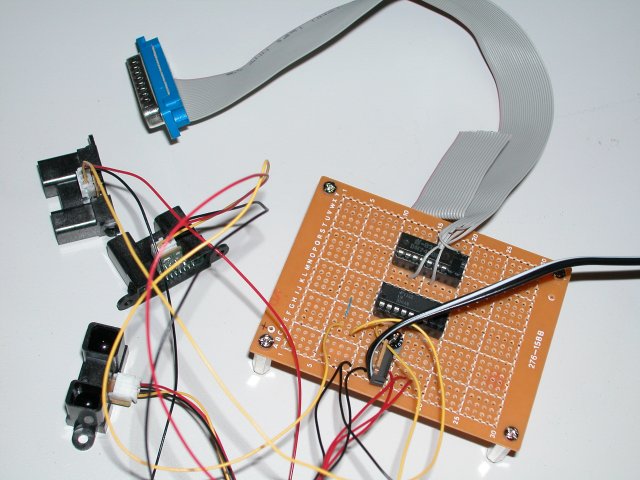
By the way, check out Scott's work here:

To bring you up to speed, I am working on a collaboration with painter/video artist Scott Hutchison. It will be a slot where computer projected images of eyes will follow you as you walk by the work. The eyes will actually be Scott's eyes, as painted and animated by him. My part to play is the sensor work and software behind it.
Here is an image of the wire-wrap board for the Eyes project. Right now there is just a 7805 5V regulator, a potentiometer to set the distance desired for the sensors, the three Sharp GP2Y0A02YK long-range IR distance sensors (long-range being 5 feet...) an LM324 analog comparator chip (which compares the analog distance voltage to the potentiometer voltage) and a 7408 quad 2-input AND chip used as a buffer to help drive the digital parallel port inputs.

By the way, check out Scott's work here:

Subscribe to:
Posts (Atom)